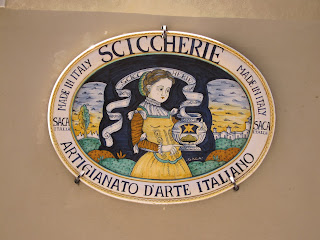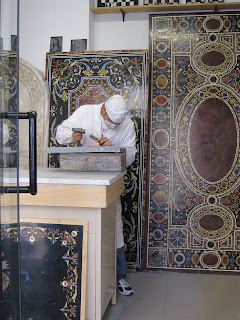June 22nd
This week we were nearing the end of our tours of Florence's churches for which many of us were just a bit grateful. In Florence, churches require that a woman's shoulders be covered and that her shorts/skirt fall below the knees which in the heat wave that had hit the city was difficult to muster the energy for.
That and some of the frescoes we were seeing were starting to blend together in our minds. Nonetheless, today we had Professor Junkerman, who is immensely passionate and inspirational, to lead us through the art and architecture of three amazing churches.
We started our tour in the church of Santa Maria del Carmine, which is on the other side of the river Arno. For the most part it is Baroque with a beautifully painted trompe l'oeil ceiling:
As we waited for our reservation to go into the Brancacci chapel we walked around and looked at some of the other Baroque and beautiful chapels, with relief and free standing sculpture that reminded me of Bernini's The Ecstasy of Saint Theresa, some beautifully painted chapel ceilings and some distant views of our intended destination.
As we waited for our allotted time we toured the cloister, the part of all the churches we visit that I always love for the peaceful energy and nature it brings into this busy and mainly cement-filled city.
Our reservation was finally available and we went to the place for which this church is famous: the Brancacci chapel. Unlike the majority of the church, this chapel dates back to the early Renaissance. The frescoes in this chapel are by three artists who are very important to the Italian Renaissance: Masolino, Masaccio, and Fillipino Lippi. The chapel was commissioned by a merchant, Felice Brancacci and it survived the fire that destroyed much of the church. It was started by Masalino in 1424 and completed 56 years later in 1480. What is very interesting about this work is that you see how artists during the Renaissance worked on the same work together (even though they might be competitive rivals or teacher and students). Here you see the active tradition of a student finishing the work of his master, one of the earliest uses of linear perspective by Masaccio (the second work, I believe, after the fresco of the crucifixion in Santa Maria Novella), and get to be present to the chapel where later giants like Michelangelo visited to sketch, learn and draw inspiration.
The frescoes that were commissioned tell the life of St. Peter. Here are some photos to look at.
Another interesting part is the background of these paintings, which is Florence. You can see the extension of the medieval buildings in the upper stories, which for the most part was outlawed/removed in the medieval town center because they prevented the entry of light into the streets. But you can see some examples today:
One place that I can easily think of is the Ponte Vecchio, where the back of shops have been extended out.
I really liked the realism of this detail. The figure at the bottom left has a birth defect in his legs and clearly the artist painted from real life. It makes the image poignant and moving. More so than if it were simply symbolic.
After we left Santa Maria del Carmine we headed to Santo Spirito which unfortunately does not allow photography. Santo Spirito was a church designed by Brunelleschi that Marco had covered in his lecture. Here we could see the Baroque architectural decoration and alteration of Brunelleschi's original plans which were made after his death (he died before he could see the church completed). Marco said that these alterations would have made the architect furious and really do disrupt the harmony of the space.
After we left Santo Spirito we walked through the artist's quarter to Santa Felicita. Here are some photos of the workshops we saw:
This week we were nearing the end of our tours of Florence's churches for which many of us were just a bit grateful. In Florence, churches require that a woman's shoulders be covered and that her shorts/skirt fall below the knees which in the heat wave that had hit the city was difficult to muster the energy for.
That and some of the frescoes we were seeing were starting to blend together in our minds. Nonetheless, today we had Professor Junkerman, who is immensely passionate and inspirational, to lead us through the art and architecture of three amazing churches.
We started our tour in the church of Santa Maria del Carmine, which is on the other side of the river Arno. For the most part it is Baroque with a beautifully painted trompe l'oeil ceiling:
As we waited for our reservation to go into the Brancacci chapel we walked around and looked at some of the other Baroque and beautiful chapels, with relief and free standing sculpture that reminded me of Bernini's The Ecstasy of Saint Theresa, some beautifully painted chapel ceilings and some distant views of our intended destination.
The Brancacci Chapel from across the Nave
As we waited for our allotted time we toured the cloister, the part of all the churches we visit that I always love for the peaceful energy and nature it brings into this busy and mainly cement-filled city.
Our reservation was finally available and we went to the place for which this church is famous: the Brancacci chapel. Unlike the majority of the church, this chapel dates back to the early Renaissance. The frescoes in this chapel are by three artists who are very important to the Italian Renaissance: Masolino, Masaccio, and Fillipino Lippi. The chapel was commissioned by a merchant, Felice Brancacci and it survived the fire that destroyed much of the church. It was started by Masalino in 1424 and completed 56 years later in 1480. What is very interesting about this work is that you see how artists during the Renaissance worked on the same work together (even though they might be competitive rivals or teacher and students). Here you see the active tradition of a student finishing the work of his master, one of the earliest uses of linear perspective by Masaccio (the second work, I believe, after the fresco of the crucifixion in Santa Maria Novella), and get to be present to the chapel where later giants like Michelangelo visited to sketch, learn and draw inspiration.
The frescoes that were commissioned tell the life of St. Peter. Here are some photos to look at.
The 3-D qualities of the frescoes are part of why they were so revolutionary. Also, the painters, probably at the request of their patrons, stuck actual Florentines into the composition, which is why you see men wearing turban-like hats which were the fashion in Florence during the Renaissance.
I'm not sure if it's easy to tell, but all the architectural features around the frescoes (the columns in the corner and the frames around the paintings) are painted and not real.
Another interesting part is the background of these paintings, which is Florence. You can see the extension of the medieval buildings in the upper stories, which for the most part was outlawed/removed in the medieval town center because they prevented the entry of light into the streets. But you can see some examples today:
One place that I can easily think of is the Ponte Vecchio, where the back of shops have been extended out.
St. Peter
I really liked the realism of this detail. The figure at the bottom left has a birth defect in his legs and clearly the artist painted from real life. It makes the image poignant and moving. More so than if it were simply symbolic.
Here you can see the altar in the chapel, which when it was done destroyed some of the original fresco. Also, you can see damage from the fire above. It really is a miracle that these frescoes survived.
The image at the top you can again see something close to what the city may have looked like. And in this image below.
Here you see what looks like a Florentine Piazza and Florentine men in the middle wearing fancy dress.
The crucifixion of Saint Peter
Detail.
St. Peter freed from prison. I love the detail of the guard sleeping at the door!
View across the nave to a Baroque chapel at the opposite end of the transcept.
After we left Santa Maria del Carmine we headed to Santo Spirito which unfortunately does not allow photography. Santo Spirito was a church designed by Brunelleschi that Marco had covered in his lecture. Here we could see the Baroque architectural decoration and alteration of Brunelleschi's original plans which were made after his death (he died before he could see the church completed). Marco said that these alterations would have made the architect furious and really do disrupt the harmony of the space.
After we left Santo Spirito we walked through the artist's quarter to Santa Felicita. Here are some photos of the workshops we saw:
We were very near the Ponte Vecchio (the jewelry bridge) so it makes sense that there would be a jewelry school nearby.
A shop selling traditional Italian pottery which Tuscany is famous for and remains in the tradition of the pottery we saw in the Bargello.
Workshop that makes inlaid marble (marmo)
Still made and sold in the traditional style, these marble inlay pieces are sold for exorbitant sums.
Finally, we arrived at Santa Felicita, our final stop. It is just on the other side of the Ponte Vecchio and is significant for several reasons.
1. It is one of the oldest churches in Florence
2. It is a part of the Vasari Corridor
3. It contains a beautiful painting called The Deposition by Pontormo in a chapel designed by Brunelleschi
Here are some pictures:
The Nave
The Nave facing the entrance. The balcony that you see is a part of the Vasari Corridor which spans the Arno and protected the Grand Duke Cosimo de Medici (Cosimo Primo) from being assassinated and ensured that he could safely walk from his residence in the Pitti Palace all the way to the Palazzo Vecchio where he went to work. This church is next to the Pitti Palace and from here the corridor is built across the Ponte Vecchio (covered up by all of the shops) and then into the Uffizzi until finally reaching its destination. According to our professor, it is very difficult and very expensive to be able to take a walking tour along it. Sadly we couldn't.
Pontormo's Deposition
Detail. Now that it has been restored the colors are beautiful.
This is the side view of the chapel, where you can get a tiny sense of Brunelleschi's design. The painted decoration would not have pleased him.
The Virgin Mary. Also found in the chapel.
What was also unique about this church is that in order to view Pontormo's work, one had to deposit a Euro a minute to view it. A smart way to make money for the church besides the usual postcard offerings.





































No comments:
Post a Comment